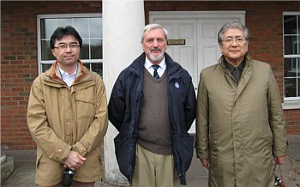 Prof Toru Furuichi and Prof Kazuei Ishii from Hokkaido University, Japan visited WIT recently due to their interest in energy generation from biomass. The two professors were warmly welcomed at WIT by Prof Carlos Brebbia who gave a presentation on the overall research activities at the Institute and this was followed by two presentations, the first of which entitled ‘Quality Properties of Biomass Fuels for Domestic Heating Systems’, was presented by Prof Montserrat Zamorano and Ángela García Maraver from the University of Granada in Spain. Their presentation described the pelletisation of biomass which involves the mass and energy densification of materials that possess low bulk densities such as sawdust, straw, and other herbaceous energy crops. This process reduces transportation costs, and provides better handling and feeding of the biomass with less dust formation. In general, pellet quality depends on the chemical, mechanical, and physical properties of biomass in terms of thermal utilization.
Prof Toru Furuichi and Prof Kazuei Ishii from Hokkaido University, Japan visited WIT recently due to their interest in energy generation from biomass. The two professors were warmly welcomed at WIT by Prof Carlos Brebbia who gave a presentation on the overall research activities at the Institute and this was followed by two presentations, the first of which entitled ‘Quality Properties of Biomass Fuels for Domestic Heating Systems’, was presented by Prof Montserrat Zamorano and Ángela García Maraver from the University of Granada in Spain. Their presentation described the pelletisation of biomass which involves the mass and energy densification of materials that possess low bulk densities such as sawdust, straw, and other herbaceous energy crops. This process reduces transportation costs, and provides better handling and feeding of the biomass with less dust formation. In general, pellet quality depends on the chemical, mechanical, and physical properties of biomass in terms of thermal utilization.
Apart from the energy content of the pellets, end-consumers are mainly concerned with two problem areas: (i) emissions generated by pellet combustion; (ii) the use of pellets in boilers and stoves. This is understandable since emissions and low-quality biofuels can damage combustion equipment and produce undesired effects such as slagging, corrosion, and interference with process control. Furthermore, the content of fine particles in the fuel, which is extremely dependent on mechanical durability as well as logistics and storage, can disturb the regulation of highly automated heating systems or interrupt automated fuel feeding. In addition, fine particles burn more quickly, and these higher temperatures can favour ash melting.
This was followed by a presentation by the head of WIT’s Environmental Fluid Mechanics Division, Prof Viktor Popov, with a particular interest in biomass utilisation. The presentation entitled ‘A Method for Optimising the Production and Utilization of Landfill Gas’ described a concept to reduce the problems related to air ingress into landfills where landfill gas (LFG) is extracted to be used as an energy source. The concept offers better control over the processes inside the repository, increase in methane production, increase in extraction rates and adaptation of smaller landfills for LFG utilization.
After lunch a site visit was arranged to view the Chatsworth Blue Haze landfill site near Ringwood, which was hosted by Steve West of Veolia. The visit was most informative in which details were given on the way landfill gas is used to produce electrical output which is fed directly into the national grid. This was followed by a tour of the site to look at the construction of the landfill itself.

 Wessex Institute
Wessex Institute